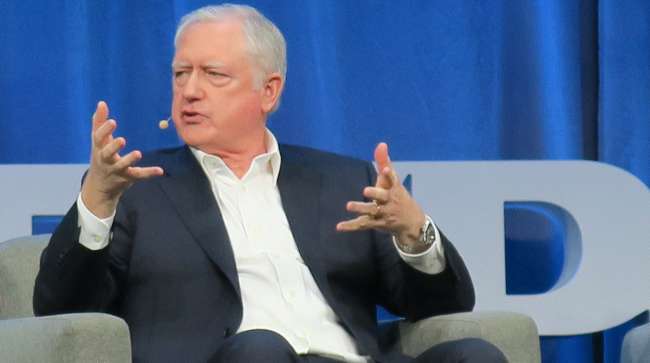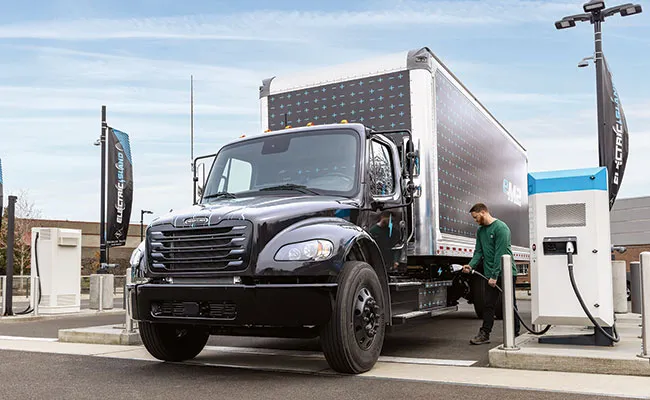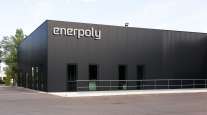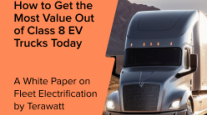Managing Editor, Features and Multimedia
DTNA’s O’Leary: EV Infrastructure Buildout Still Lagging

[Stay on top of transportation news: Get TTNews in your inbox.]
LAS VEGAS — Battery-electric trucks are on the market and increasingly on the road as early adopters gradually deploy these zero-emission vehicles in their fleets, but Daimler Truck North America CEO John O’Leary said the scarcity of charging infrastructure continues to constrain the pace of industry adoption.
“I think what’s lacking is an end-to-end plan” to meet the power and charging demands of battery-electric truck fleets, O’Leary said during a one-on-one interview with Transport Topics at the Advanced Clean Transportation Expo, held May 20-23.
His overall assessment of the state of electric truck charging has changed little since he warned that infrastructure buildout efforts were “flailing” a year ago during his keynote speech at ACT Expo 2023.
Now, a year later, O’Leary said the situation has not improved significantly, and could even be considered worse due to the amount of time that has transpired without accelerating the adoption curve.
.@DaimlerTruckNA combines autonomous driving with a battery-electric powertrain in its Autonomous eCascadia demonstrator truck, on display here at @ACTExpo. pic.twitter.com/5SifeA492A — Seth Clevenger (@SethClevenger) May 21, 2024
“Things are not as robust as I would have hoped 12 months ago,” he said. “For sure, there’s a little more charging capability out there, a little more infrastructure, but the fact that industry sales have leveled off would indicate that we haven’t made progress — or very little progress.”
O’Leary suggested that a more coordinated approach to electric vehicle infrastructure planning is needed, involving stakeholders such as utility providers, municipalities and government regulators.
To date, charging infrastructure development has generally proceeded on an individual project basis.
“It’s just everybody doing what they think they can and should do, piecemealing it all together with no master plan,” O’Leary said.

DTNA's Freightliner eM2's has a range of 180 to 250 miles on a single charge. (Daimler Truck North America)
At the same time, power demand is rising from other parts of the economy, including data centers to support artificial intelligence capabilities, he added. “That just exacerbates the challenge.”
In addition to battery-electric trucks, DTNA and its competitors are investing in several other technology pathways as the industry transitions toward low- and zero-emission vehicles.
While there will be some other alternatives on the market, DTNA sees diesel, battery-electric, hydrogen combustion and hydrogen fuel cell as the “four primary options for the future,” O’Leary said.
The fact that industry sales have leveled off would indicate that we haven’t made progress — or very little progress.
Daimler Truck North America CEO John O'Leary
The manufacturer of Freightliner and Western Star trucks plans to continue offering diesel engines — which power the overwhelming majority of new trucks today — through 2039, although that timing could depend on the future course of regulations and macro events that might impact the cost of diesel vehicles, O’Leary said.
The long-term market for battery-electric commercial vehicles, he said, will be in light- and medium-duty applications and in heavy-duty trucks that run shorter routes, including drayage and regional operations. While battery chemistry will continue to improve, O’Leary said it is unlikely that battery-electric trucks will be able to reach 1,000 miles on a single charge in the foreseeable future.
For the longer distances required by coast-to-coast longhaul trucking, as well as for vocational operations in remote areas with no access to electric vehicle charging, DTNA sees hydrogen as the eventual answer.
Robby Hamby of Bridgestone Americas and Ken Eggen of Wolf River Express share how fleets should acquire the right tire monitoring tools for data collection. Tune in above or by going to RoadSigns.ttnews.com.
That will start with hydrogen combustion, O’Leary said, because it’s easier to develop and industrialize in the near term due to its commonalities with the diesel engine platform.
That segment of the market eventually will migrate to hydrogen fuel cell electric, likely starting in the early to mid 2030s, as that technology becomes higher volume, more affordable and more efficient, he added.
“Ultimately this industry chases efficiency because it’s all about [total cost of ownership],” O’Leary said.
While future technology breakthroughs could change this outlook, DTNA’s current view is that the commercial truck market, as time goes on, will increasingly shift toward battery-electric and hydrogen fuel cell electric as the predominant technologies.
Along the way, fleet operators will face a growing challenge: selecting the right equipment for their businesses from an expanding menu of powertrain options.
“I think what helps them the most is us having the best products out there,” O’Leary said. “That’s what we aspire to do.”
Even as the powertrain technology mix changes, top industry priorities such as TCO, vehicle uptime and service capabilities will remain, he said. “That is just as important in the future as it is today.”
Want more news? Listen to today's daily briefing below or go here for more info:





